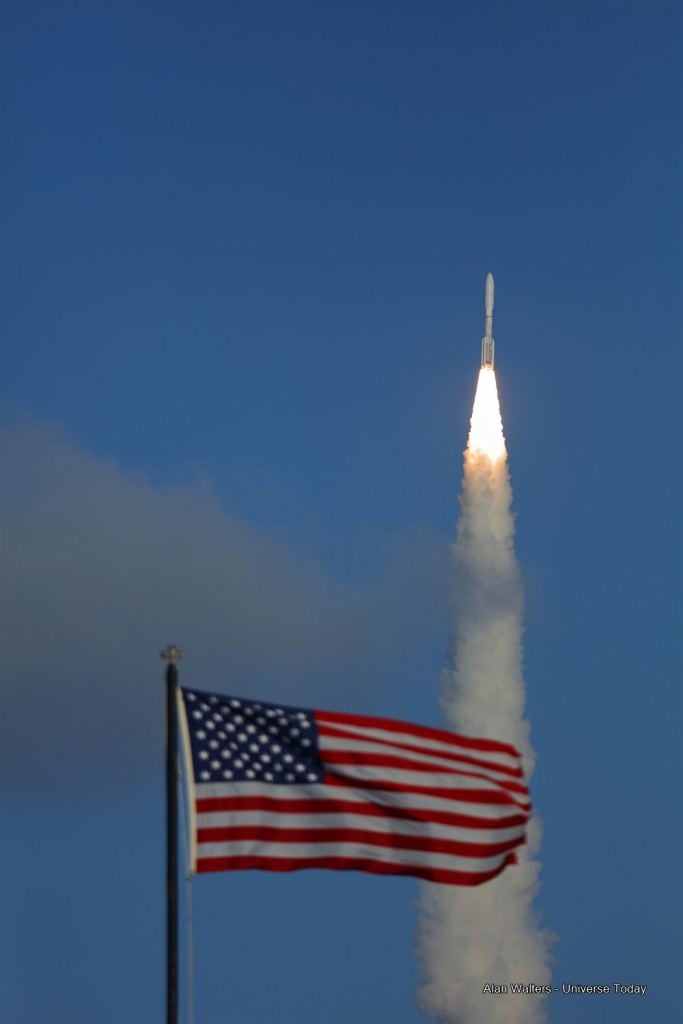NASA and NOAA now have a sophisticated new weather satellite in space. The GOES-T satellite launched on the powerful United Launch Alliance (ULA) Atlas V rocket on March 1, and it will provide forecasters with high resolution weather imagery. It will also provide real-time monitoring of events on the ground like wildfires, floods and landslides, while monitoring atmospheric and climate dynamics over the Western US and Pacific Ocean.
The liftoff from Cape Canaveral Space Force Station of GOES-T (Geostationary Operational Environmental Satellite-T) provided stunning views, and incredibly, other satellites looked down and captured the launch of the new satellite from space, such as this shot from its older sibling, GOES-16:
Loading tweet...
— View on Twitter
More satellite views of the launch below, but first, photographer Mike Killian took part in a stunning photo shoot from the air, capturing a the launch in the background while a restored F-86 Sabre jet flew over the Space Coast:
Loading tweet...
— View on Twitter
A few more of the GOES satellites already in high geosynchronous orbits looked down on the launch:
Loading tweet...
— View on Twitter
Loading tweet...
— View on Twitter
Loading tweet...
— View on Twitter
Loading tweet...
— View on Twitter
And of course, there are always amazing views from the ground. Above, Manuel Mazzati focused his high-resolution camera on the flames from the rocket just after liftoff.
Alan Walters attended the launch on behalf of Universe Today and caught these gems:
And you can always count on Ben Coope r for a unique launch perspective:
Loading tweet...
— View on Twitter
And then there's this stunner from Michael Cain:
Loading tweet...
— View on Twitter
For the full experience, here's a video of the launch via NASA:
Loading tweet...
— View on Twitter
The launch placed GOES-T in a high perigee orbit of over 8,000 km (~ 5,000 miles). Its final orbital position in geosynchronous orbit will be just over 35,000 km (22,000 miles) above Earth's equator.
"The Atlas V delivered GOES-T directly to a geosynchronous transfer orbit," said Gary Wentz, ULA vice president of Government and Commercial Programs, in a press release. "The orbital delivery accurately placed the spacecraft closer to its final destination which conserves the satellite's fuel supply and enables a longer mission life."
Once it reaches its final orbit, the satellite will undergo commissioning and checkouts over the next few months and be fully operational by early 2023. It joins four other GOES satellites currently in service, GOES-14, -15, -16 and -17. Once in service, the new satellite will be renamed GOES-18 and it will take over for GOES-17, which launched on another Atlas 5 exactly four years ago. GOES-17 has had problems with its main weather instrument, but it will remain in orbit as a backup in case any other of the GOES weather satellites encounters any problems in the future.
This was the 92ndlaunch of an Atlas V rocket, and ULA says they have launched 149 times with 100 percent mission success.
Lead image caption: *A United Launch Alliance (ULA) Atlas V rocket carrying NOAA's GOES-T satellite, launching for NASA's Launch Services Program, lifts off from from Space Launch Complex-41 at 4:38 p.m. EST on March 1, 2022. Photo Credit: United Launch Alliance*
 Universe Today
Universe Today


